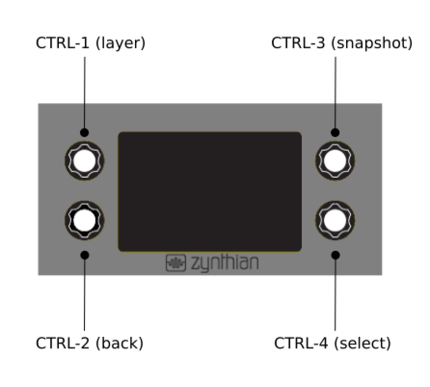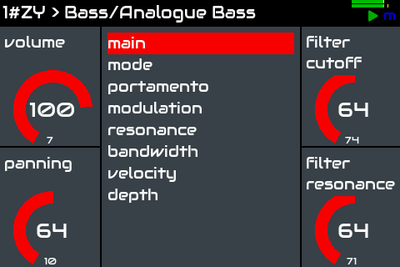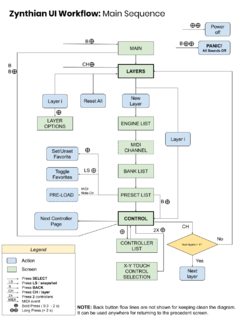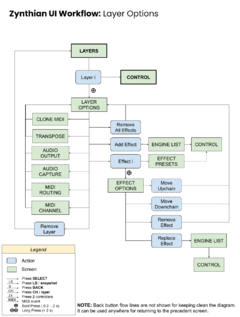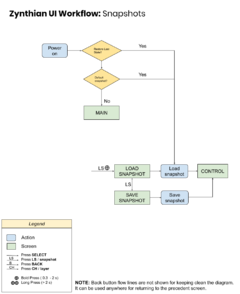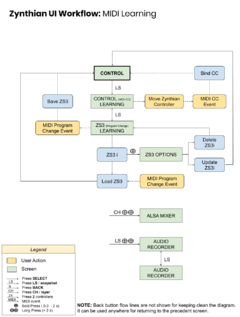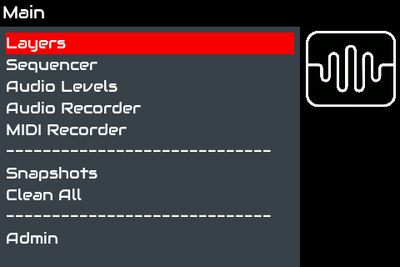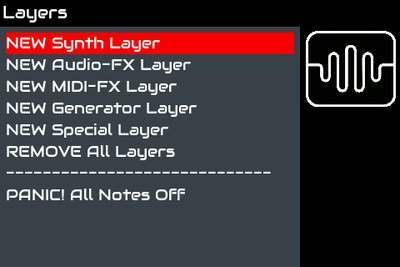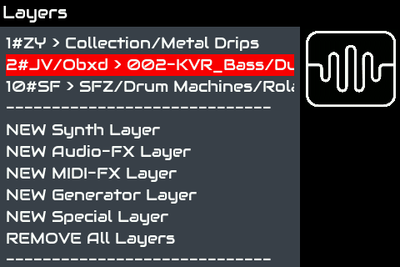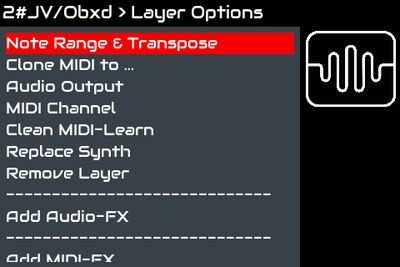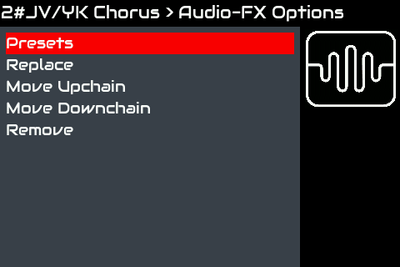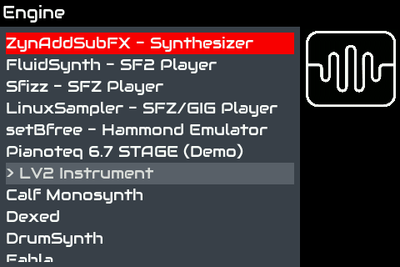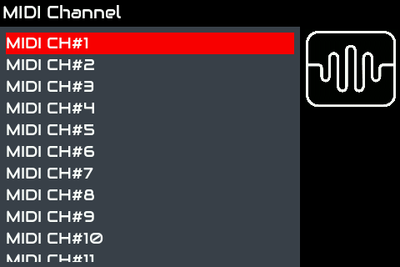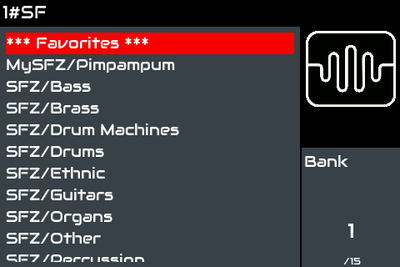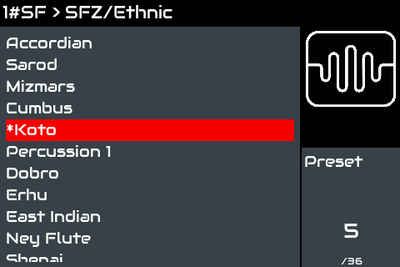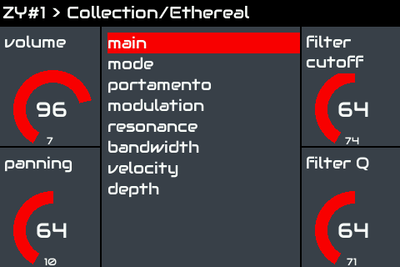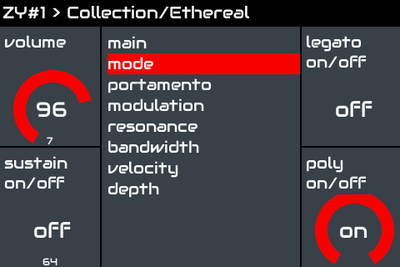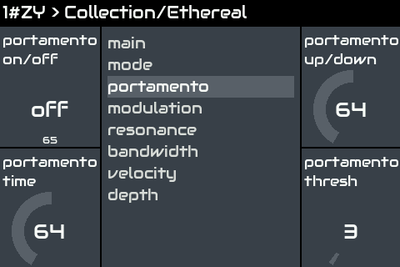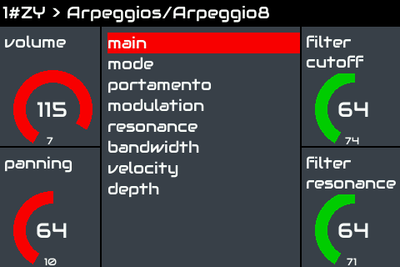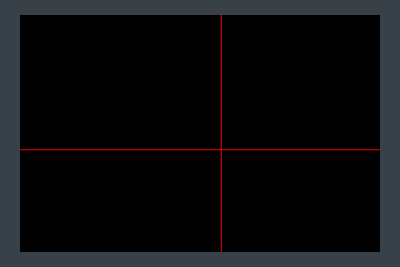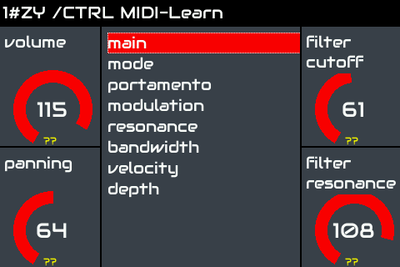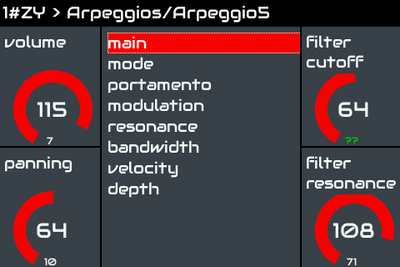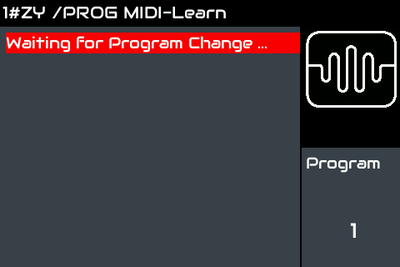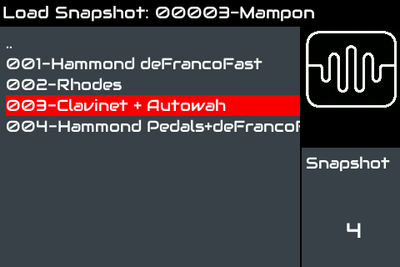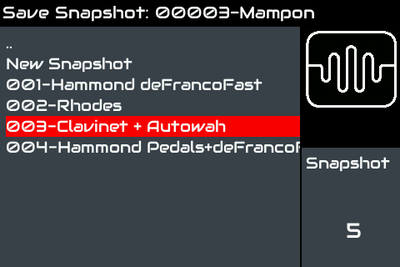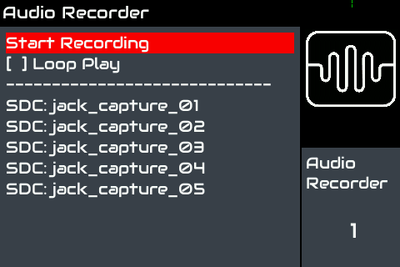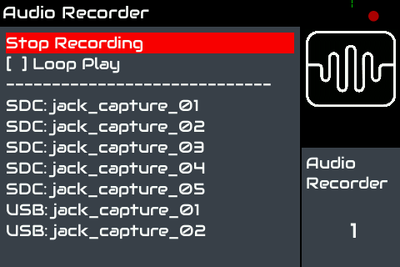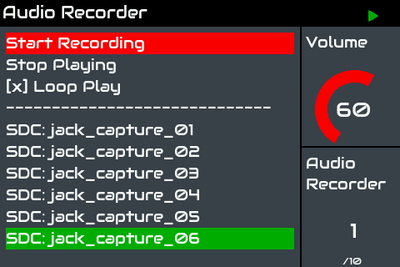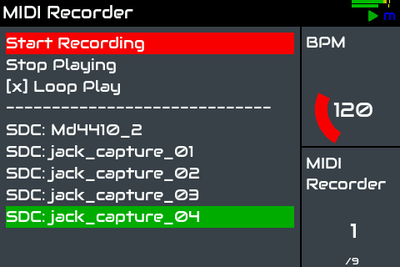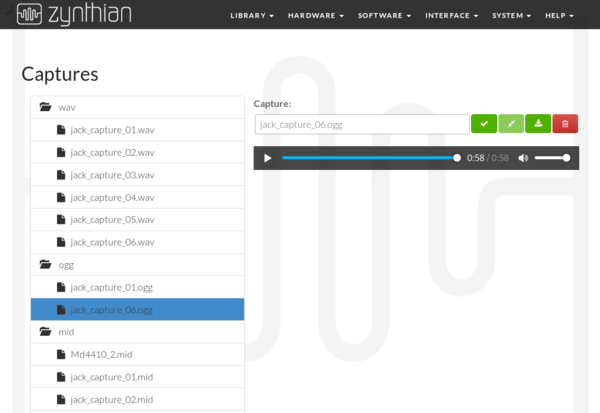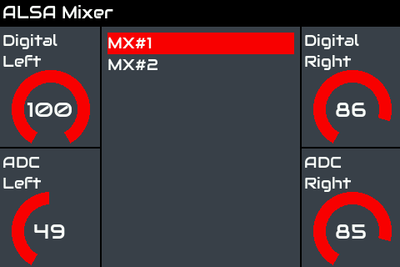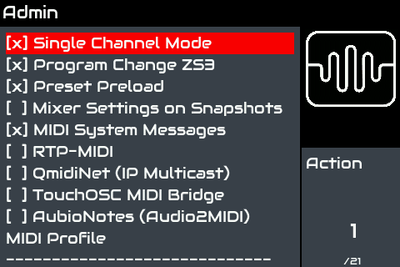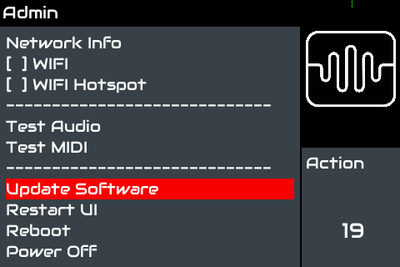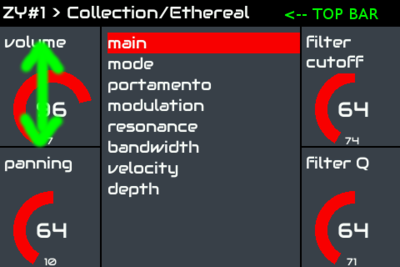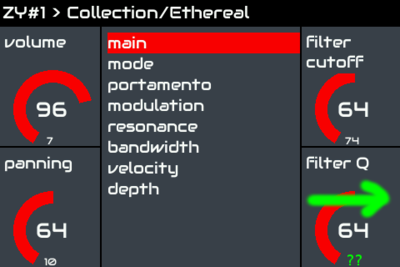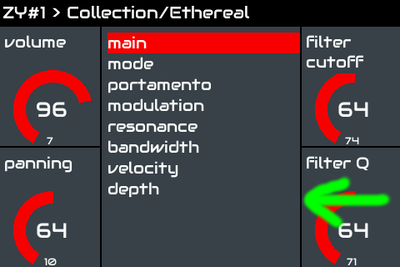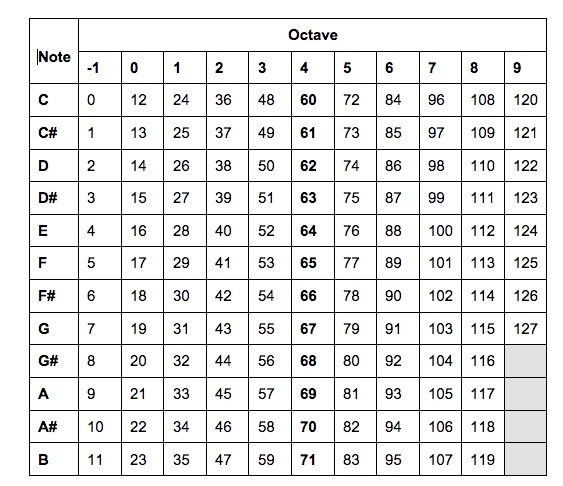Difference between revisions of "Zynthian UI User Guide (oldstable-2109)"
| (28 intermediate revisions by 2 users not shown) | |||
| Line 34: | Line 34: | ||
* '''long-snapshot''': Audio Recorder | * '''long-snapshot''': Audio Recorder | ||
* '''long-select''': Power Off | * '''long-select''': Power Off | ||
| − | |||
<br clear=all> | <br clear=all> | ||
| Line 84: | Line 83: | ||
* Finally, the '''Red Circle''' and '''Green Play''' flags show the status of audio/MIDI capture: recording / playing | * Finally, the '''Red Circle''' and '''Green Play''' flags show the status of audio/MIDI capture: recording / playing | ||
| − | =Main | + | <br clear=all> |
| + | |||
| + | =The Zynthian UI Workflow= | ||
| + | |||
| + | The following flowcharts show the different "screens" or "menus" and how to reach each one using the 4 switches. | ||
| + | It would be a good idea to print these flowcharts and keep them near your Zynthian Box until you memorize the workflow. | ||
| + | |||
| + | <gallery mode="slideshow" widths="240" heights="320"> | ||
| + | Image:zynthian_ui_workflow__main.png|''[[commons:Main Sequence|Main Sequence]]'' | ||
| + | Image:zynthian_ui_workflow__layer_options.png|''[[commons:Layer Options|Layer Options]]'' | ||
| + | Image:zynthian_ui_workflow__snapshots.png|''[[commons:Snapshots|Snapshots]]'' | ||
| + | Image:zynthian_ui_workflow__midi_learning.png|''[[commons:MIDI Learning|MIDI Learning]]'' | ||
| + | </gallery> | ||
| + | |||
| + | If you want to contribute to improving these flowcharts, you can edit them using the Google Documents Tools: | ||
| + | |||
| + | - [https://docs.google.com/drawings/d/1jmt3zrJjPkbqj3hpzCIwRgFIKxiX2UptebBA_GN8e5I Main sequence: zynthian_ui_workflow_main] | ||
| + | - [https://docs.google.com/drawings/d/1C8kfovwXxuabl1u-UlrnHY8xzFFNiqiQWt1mmD5UXak Layer Options: zynthian_ui_workflow_layer_options] | ||
| + | - [https://docs.google.com/drawings/d/1Um1HVCvvb4gZF_X-vcIN9cTxYIBRCtZ5oxniUdSTB3c Snapshots: zynthian_ui_workflow_snapshots] | ||
| + | - [https://docs.google.com/drawings/d/1I0ArYVr3zGtzcSgOy19fHlIh8VF15rmsll9wZi-aXaI MIDI Learning: zynthian_ui_workflow_midi_learning] | ||
| + | |||
| + | <br clear=all> | ||
| + | |||
| + | =The UI Screens= | ||
| + | |||
| + | ==Main== | ||
[[File:Zynthian_ui_main.png|400px|right]] | [[File:Zynthian_ui_main.png|400px|right]] | ||
| + | This is the first screen you would see when you power on your zynthian for first time and no default snapshot or last-state snapshot has been saved yet. | ||
The Main menu gives easy and intuitive access to the Zynthian-UI's main features: | The Main menu gives easy and intuitive access to the Zynthian-UI's main features: | ||
| Line 98: | Line 123: | ||
* '''Admin''' | * '''Admin''' | ||
| − | You can access this menu | + | You always can access this menu with '''bold-back'''. |
The Zynthian-UI has a lot of short-cuts and most of the options on the Main menu can be accessed on this way, but until you learn the shortcuts and feel comfortable with them, you will find this menu very useful. | The Zynthian-UI has a lot of short-cuts and most of the options on the Main menu can be accessed on this way, but until you learn the shortcuts and feel comfortable with them, you will find this menu very useful. | ||
| Line 104: | Line 129: | ||
<br clear=all> | <br clear=all> | ||
| − | =Layers= | + | ==Layers== |
| − | |||
| − | |||
Layers are a key concept on Zynthian-UI: the first thing you do when you power-on your zynthian is, probably, create a layer. | Layers are a key concept on Zynthian-UI: the first thing you do when you power-on your zynthian is, probably, create a layer. | ||
| Line 121: | Line 144: | ||
All units in a layer receive all the MIDI events coming from the assigned channel. Some special layers (MOD-UI) don't have an assigned MIDI channel and receive all MIDI channels. | All units in a layer receive all the MIDI events coming from the assigned channel. Some special layers (MOD-UI) don't have an assigned MIDI channel and receive all MIDI channels. | ||
| − | You can | + | You can access the Layer screen: |
| − | |||
| − | |||
| − | |||
| − | |||
| − | |||
| − | |||
| − | |||
| − | |||
| − | |||
| − | |||
| − | |||
| − | |||
| − | |||
| − | |||
| − | |||
| − | |||
| − | |||
| − | |||
| − | |||
| − | |||
| − | |||
| − | |||
| − | |||
| − | |||
| − | |||
| − | + | * from any place, '''bold-layer''' | |
| − | + | * from Main menu | |
| − | |||
| − | |||
| − | |||
| − | |||
| − | |||
| − | |||
| − | |||
| − | |||
| − | |||
| − | |||
| − | |||
| − | |||
| − | |||
| − | |||
| − | |||
| − | |||
[[File:Zynthian_ui_new_layer.png|400px|right]] | [[File:Zynthian_ui_new_layer.png|400px|right]] | ||
| − | |||
| − | There are several options on | + | There are several options on layers screen: |
* '''NEW Synth Layer''' => Create a new Synthesizer Layer. | * '''NEW Synth Layer''' => Create a new Synthesizer Layer. | ||
| Line 183: | Line 164: | ||
<br clear=all> | <br clear=all> | ||
| − | [[File: | + | [[File:Zynthian_ui_layers.png|400px|right]] |
| − | When you select '''NEW Synth/Effect/Generator Layer''', you create a new root-layer (first of a chain), choosing a free MIDI channel for it. You can create up to 16 layers (as many as MIDI channels), each one having an independent effect-chain. | + | When you select '''NEW Synth/Effect/Generator/Special Layer''', you create a new root-layer (first of a chain), choosing a free MIDI channel for it. You can create up to 16 layers (as many as MIDI channels), each one having an independent effect-chain. |
Having several layers in the same MIDI channel is not allowed. If you want two or more layers playing unison (like being in the same MIDI channel), you should use the "Clone" feature, which allow you to bind several layers while keeping MIDI CCs and other MIDI messages (Program Change, Channel Pressure, etc.) independent. | Having several layers in the same MIDI channel is not allowed. If you want two or more layers playing unison (like being in the same MIDI channel), you should use the "Clone" feature, which allow you to bind several layers while keeping MIDI CCs and other MIDI messages (Program Change, Channel Pressure, etc.) independent. | ||
| Line 218: | Line 199: | ||
<br clear=all> | <br clear=all> | ||
| − | ==Engine | + | ==Engine Selector== |
[[File:Zynthian_ui_engine_list.png|400px|right]] | [[File:Zynthian_ui_engine_list.png|400px|right]] | ||
When you create a new layer, you are asked which engine/plugin you want to use for it. A list of engines to choose from is displayed. They can be synthesizers, effects, generators or special engines, depending on the type of layer you are creating. When you select an element from the list, the zynthian logo on the top-right will be animated while the engine is being started. | When you create a new layer, you are asked which engine/plugin you want to use for it. A list of engines to choose from is displayed. They can be synthesizers, effects, generators or special engines, depending on the type of layer you are creating. When you select an element from the list, the zynthian logo on the top-right will be animated while the engine is being started. | ||
| Line 234: | Line 215: | ||
<br clear=all> | <br clear=all> | ||
| − | ==MIDI Channel | + | ==MIDI Channel selector== |
[[File:Zynthian_ui_midi_channel.png|400px|right]] | [[File:Zynthian_ui_midi_channel.png|400px|right]] | ||
This screen is shown in various contexts: | This screen is shown in various contexts: | ||
| Line 244: | Line 225: | ||
<br clear=all> | <br clear=all> | ||
| − | == Bank | + | == Bank selector== |
[[File:Zynthian_ui_bank_list.png|400px|right]] | [[File:Zynthian_ui_bank_list.png|400px|right]] | ||
Presets (instruments, patches, or sound designs) for a synth engine are organized into banks. Choose a bank to see the list of presets you can pick from within that bank. | Presets (instruments, patches, or sound designs) for a synth engine are organized into banks. Choose a bank to see the list of presets you can pick from within that bank. | ||
<br clear=all> | <br clear=all> | ||
| − | ==Preset | + | ==Preset selector== |
[[File:Zynthian_ui_preset_list.png|400px|right]] | [[File:Zynthian_ui_preset_list.png|400px|right]] | ||
Once you have chosen a bank, the preset screen will be shown. Choose a preset to load the instrument/sound/patch you want and the Control Instrument screen will be shown. | Once you have chosen a bank, the preset screen will be shown. Choose a preset to load the instrument/sound/patch you want and the Control Instrument screen will be shown. | ||
| Line 255: | Line 236: | ||
If the '''preload with note-on''' feature is enabled, you can preload the presets by playing notes. When you do so, the highlighted preset will be pre-loaded before clicking select. | If the '''preload with note-on''' feature is enabled, you can preload the presets by playing notes. When you do so, the highlighted preset will be pre-loaded before clicking select. | ||
| − | You can return to the control screen directly, without selecting any preset, by clicking | + | You can return to the control screen directly, without selecting any preset, by clicking '''bold-back'''. In that case, the previously selected instrument will be restored in case you pre-loaded some preset. |
| + | |||
| + | Use '''bold-select''' for adding a preset to your favorites. You will see a little '''*''' at left. '''Bold-select''' again for removing the preset from favorites. For listing only your favorite presets, use '''bold-snapshot'''. | ||
<br clear=all> | <br clear=all> | ||
| − | == | + | ==Control screen== |
[[File:Zynthian_ui_instrument_control_01.png|400px|right]] | [[File:Zynthian_ui_instrument_control_01.png|400px|right]] | ||
This screen is shown after you have chosen a preset. Your instrument is now enabled and playable and you can modify the parameters. | This screen is shown after you have chosen a preset. Your instrument is now enabled and playable and you can modify the parameters. | ||
| Line 285: | Line 268: | ||
<br clear=all> | <br clear=all> | ||
| − | ==== | + | ==MIDI-learning== |
| − | You can | + | |
| + | MIDI-learning allows you to easily bind specific MIDI events with Zynthian-UI actions. There are 2 types of MIDI events you can learn: | ||
| + | |||
| + | ====MIDI CC==== | ||
| + | [[File:Zynthian_ui_midi_cc_learn_01.png|400px|right]] | ||
| + | [[File:Zynthian_ui_midi_cc_learn_02.png|400px|right]] | ||
| + | You can map any parameter in the Zynthian UI to a CC knob/slider on your external MIDI controller. I intend to extend this feature to other MIDI messages, but currently only CC messages are supported. Until then, MIDI-filter rules can be used instead. | ||
| + | |||
| + | Learning a MIDI-CC is quite easy: | ||
| + | |||
| + | '''1.''' From the control screen, you click the snapshot button. You will be in CC MIDI-learn screen. It’s identical to the Control screen except that all the controllers have a tiny yellow “???” in the bottom. | ||
| + | |||
| + | '''2.''' Move a zynthian controller. Its tiny “???” will change to green while the other 3 will go back to normal state. | ||
| + | |||
| + | '''3.''' Finally, move a knob/fader in your MIDI keyboard/controller and the binding is done. The new CC number should appear in the bottom of the learned controller, replacing the tiny "???". | ||
| + | |||
| + | Of course, MIDI-learning configuration, including CC mappings, is stored and restored with snapshots. | ||
| + | |||
| + | '''Technical Note:''' MIDI-CC learning works with all the engines. It uses the engine’s native MIDI-learning capabilities when available. Zynthian’s MIDI-filter mappings are used for the rest. To be more explicit, native MIDI-learning is used for MOD-UI and ZynAddSubFX OSC parameters. All the other parameters are managed by Zynthian’s MIDI-filter mapping. | ||
| + | |||
| + | <br clear=all> | ||
| + | |||
| + | ====MIDI Program Change==== | ||
| + | [[File:Zynthian_ui_midi_zs3_learn.png|400px|right]] | ||
| + | You can map "SubSnapshots" (ZS3) to MIDI programs. The idea behind this feature is to have a fast preset-change mechanism that can be used on stage. In combination with the “Single Layer” feature, it turns Zynthian in a “Stage-Beast”. You can prepare a snapshot for the full performance, and use ZS3 for fast changing from a song to another, or between parts inside the same song. | ||
| + | |||
| + | Learning a SubSnapShot is obscenely easy: | ||
| + | |||
| + | '''1.''' From the control screen, you click the snapshot button '''twice'''. You will see the current list of ZS3s and a message: “Waiting for Program Change…” | ||
| − | + | '''2.''' Simply push a “Program Change” button in your keyboard/controller and the ZS3 will be stored in memory, associated with the Program number you send. | |
| + | |||
| + | After that, you can recall any stored ZS3 by simply pushing the same PC button again. Of course, the memory-stored zs3s will be saved with your snapshot and restored when loaded again. | ||
| + | |||
| + | Every zs3 includes: | ||
| + | |||
| + | - Layer ID | ||
| + | - Bank | ||
| + | - Preset | ||
| + | - Controller values | ||
| + | |||
| + | As you can see, it has sense in a SnapShot context, where a set of layers are defined. Zs3 changing is very fast, as no engine have to be started. | ||
<br clear=all> | <br clear=all> | ||
| − | == | + | ==Load/Save Snapshot== |
[[File:Zynthian_ui_snapshot_load.png|400px|right]] | [[File:Zynthian_ui_snapshot_load.png|400px|right]] | ||
[[File:Zynthian_ui_snapshot_save.png|400px|right]] | [[File:Zynthian_ui_snapshot_save.png|400px|right]] | ||
Snapshots are used for saving and restoring the status of Zynthian. A snapshot includes the full state, including layers, effects, parameter values, MIDI-learning, etc. | Snapshots are used for saving and restoring the status of Zynthian. A snapshot includes the full state, including layers, effects, parameter values, MIDI-learning, etc. | ||
| − | You can enter the ''Load Snapshot'' screen | + | You can enter the ''Load Snapshot'' screen with '''bold-snapshot'''. It works from any place. A second click and you will be at the ''Save Snapshot'' screen. |
Before loading any snapshot, you should save one, and to save a snapshot, you should create some layers, etc. The Zynthian UI will use numbers for naming the banks and snapshots. You can rename the snapshots to something more specific using the webconf tool. | Before loading any snapshot, you should save one, and to save a snapshot, you should create some layers, etc. The Zynthian UI will use numbers for naming the banks and snapshots. You can rename the snapshots to something more specific using the webconf tool. | ||
| Line 310: | Line 332: | ||
====Restore Last State==== | ====Restore Last State==== | ||
If "Restore last state on startup" option is enabled on webconf (it's enabled by default), then the state will be saved when powering off (using long-click select or from Admin Menu) and restored on next boot. This option has priority over the "Default Snapshot". | If "Restore last state on startup" option is enabled on webconf (it's enabled by default), then the state will be saved when powering off (using long-click select or from Admin Menu) and restored on next boot. This option has priority over the "Default Snapshot". | ||
| − | |||
| − | |||
| − | |||
| − | |||
| − | |||
| − | |||
| − | |||
| − | |||
| − | |||
| − | |||
| − | |||
| − | |||
| − | |||
| − | |||
| − | |||
| − | |||
| − | |||
| − | |||
| − | |||
| − | |||
| − | |||
| − | |||
<br clear=all> | <br clear=all> | ||
| Line 341: | Line 341: | ||
[[File:zynthian_ui_midi_recorder.png|400px|right]] | [[File:zynthian_ui_midi_recorder.png|400px|right]] | ||
| − | + | These simple tools allow you to record Audio & MIDI tracks easily, using the internal SD-card or an USB memory stick for storing the files. | |
| + | |||
| + | For accessing the Audio & MIDI recording tools: | ||
| + | |||
| + | * From the '''Main menu''', select Audio Recorder | ||
| + | * From any place, '''long-snapshot''' | ||
| + | |||
| + | When you are in, '''short-snapshot''' for switching between Audio & MIDI Recorder. | ||
| + | |||
'''WARNING!''' Using the internal SD card to store the captured files will increase the risk of corruption. You should use a USB memory stick instead. | '''WARNING!''' Using the internal SD card to store the captured files will increase the risk of corruption. You should use a USB memory stick instead. | ||
| Line 384: | Line 392: | ||
<br clear=all> | <br clear=all> | ||
| − | = | + | ==ALSA Mixer== |
| − | |||
| − | |||
| − | + | [[File:zynthian_ui_mixer_control.png|400px|right]] | |
| − | + | The '''ALSA Mixer''' app is a pseudo-layer that allows to adjust the soundcard output/input levels and other audio-hardware related options. Technically speaking, it's a user interface for the ALSA (Audio Linux Sound Architecture) mixer. | |
| − | + | For accessing the '''ALSA-Mixer''' app, you have 2 options: | |
| − | + | * Selecting "ALSA-Mixer" option from the Main menu | |
| + | * '''Long-pushing the layer knob (CTRL-1)''' | ||
| − | + | You can configure the mixer controllers from the webconf's hardware->audio menu. Simply click the '''+''' button on the "Mixer Controls" text area. | |
| − | = | + | <br clear=all> |
| − | |||
| − | |||
| − | |||
| − | + | ==Admin Menu== | |
| − | + | [[File:Zynthian_ui_admin.png|400px|right]] | |
| + | [[File:Zynthian_ui_admin_02.png|400px|right]] | ||
| − | + | The Admin menu give access to some configuration options (most of them also accessible from the webconf tool). | |
| − | + | For accessing this menu: | |
| − | + | * From any place, '''long-back''' | |
| − | + | * From Main menu | |
| − | |||
<br clear=all> | <br clear=all> | ||
| − | == | + | = Touch Screen UI= |
| − | |||
| − | |||
| − | + | [[File:Zynthian_ui_top_bar.png|400px|right]] | |
| + | You can navigate and control the Zynthian UI without knobs/encoders/switches at all, using only the touchscreen (or mouse). | ||
| − | ''' | + | You can "emulate" the switches by tapping the controller widgets (squares in the 4 corners of the screen). There are short, bold and long actions, same behaviour than rotary encoders work-flow. The only screen having the 4 controller widgets is the "Instrument Control" screen. Most of screens are selectors, which only have 1 controller widget. On those screens you can click the '''zynthian logo''' (top-right) to emulate the "snapshot" switch, and you can go back by tapping the '''top-bar''' area. |
| − | + | You can change the controller values by "sliding" up/down over the widgets. (see the green arrow in the figure) This is the same as turning the knob. If you are using a mouse, the mouse wheel also can be used to change the controller value. | |
| − | |||
| − | |||
| − | |||
| − | |||
| − | |||
| − | |||
| − | |||
| − | |||
| − | |||
| − | |||
<br clear=all> | <br clear=all> | ||
====MIDI-CC Learning with a touch interface==== | ====MIDI-CC Learning with a touch interface==== | ||
| − | |||
| − | |||
[[File:Zynthian_ui_midi_learning.png|400px|right]] | [[File:Zynthian_ui_midi_learning.png|400px|right]] | ||
| Line 454: | Line 445: | ||
1. In the "Instrument Control" screen, navigate through the parameter screen list until you get to the parameter you want to unlearn. | 1. In the "Instrument Control" screen, navigate through the parameter screen list until you get to the parameter you want to unlearn. | ||
2. In the parameter/controller area, slide with your fingernail from '''right to left'''. The tiny number, indicating the current CC assignment, should disappear or change. If the parameter is an engine-specific controlled engine, the number will disappear. If the parameter is a hardcoded MIDI-mapped parameter, the number will change. | 2. In the parameter/controller area, slide with your fingernail from '''right to left'''. The tiny number, indicating the current CC assignment, should disappear or change. If the parameter is an engine-specific controlled engine, the number will disappear. If the parameter is a hardcoded MIDI-mapped parameter, the number will change. | ||
| + | |||
<br clear=all> | <br clear=all> | ||
| − | + | =CUIA: Callable UI Actions= | |
The Zynthian UI can be controlled remotely using a set of commands called CUIA: Callable UI Actions. These CUIA are available on several interfaces: Key Bindings, MIDI, OSC, etc. | The Zynthian UI can be controlled remotely using a set of commands called CUIA: Callable UI Actions. These CUIA are available on several interfaces: Key Bindings, MIDI, OSC, etc. | ||
| Line 601: | Line 593: | ||
[[File:Midi-note-chart.jpg]] | [[File:Midi-note-chart.jpg]] | ||
| − | |||
| − | |||
| − | |||
| − | |||
| − | |||
| − | |||
| − | |||
| − | |||
| − | |||
| − | |||
| − | |||
| − | |||
| − | |||
Revision as of 03:44, 8 April 2020
1 General Concepts
The Zynthian UI is displayed on a touch display and controlled by 4 knobs (rotary-encoders with push-switches). The knobs are used to navigate between the different screens/menus, select options and change the instrument parameters, acting as MIDI/OSC controllers. You can emulate the knob's behaviour using the touch-display, but it's sub-optimal and accessing some features could be tricky.
There are two main screen-layout types:
- Selector Screen: a list of items that you can scroll and select with the SELECT (4) knob
- Controller Screen: 4 control widgets in the corners (one for each knob), with label and value indicators (graphic and numeric). In the middle there is a list of controller maps, which you can use to change the parameters controlled by the knobs.
Almost every Zynthian UI screen is of one of these 2 types, however, other screen-layouts do exist:
- Confirmation Screen: It will ask you to confirm some operation.
- XY Controller Screen: It allows to modify 2 parameters at once using the touch interface.
- Info Screen: It displays info about an operation, like "Update Software", or "Network Info"
There are 3 types of clicks (push-switch actions) that can be performed, depending on how long you hold down the knob (or hold your finger on the touch-display):
- short click: less than 0.3 seconds
- bold click: between 0.3 and 2 seconds
- long click: more than 2 seconds
Click actions for each knob are context dependent. The SELECT knob is mainly used to navigate, and a short click on it will select an item on a "Selector Screen". Inside a "Controller Screen", short clicks can be used to rotate between layers (LAYER knob) or between controller pages (SELECT knob). "Bold-clicks" are intended as shortcuts for jumping to some specific screens. Clicking the BACK knob generally jumps to the previous screen in the workflow sequence.
Most of the actions depend of context (current screen), but there are some actions that are global and will work from any screen:
- bold-back: Main menu
- bold-snapshot: Load Snapshot menu
- long-layer: ALSA Mixer app
- long-back: Admin menu
- long-snapshot: Audio Recorder
- long-select: Power Off
2 The Title Bar
The title bar have 2 functions:
- Kind of Breadcrumb, normally showing the screen title or layer information: MIDI channel, engine, bank & preset
- Back-button, when using the touch-interface. I know, it's far from intuitive, but Zynthian-UI was not designed with touch-navigation in mind.
3 The Status Area
On the top-right corner there is a small area where some useful information is displayed in real time:
- Audio Peak-meter or CPU-load => 1 or 2 small horizontal bars on the top right.
- MIDI-IN => Blue M flag
- Xrun => Red Warning flag
- Under-voltage => Red Lightning flag
- Over-temperature => Red Thermometer flag
- Recording Audio => Red Circle flag
- Playing Audio => Green Play flag
3.1 The Peak-meter
The Audio Peak-meter is shown by default. The meter covers the range -50dBFS to 0dBFS, i.e. maximum permissible level at full scale (far right) down to 50dB below (far left):
- The green segment covers the range -50dBFS to -10dBFS.
- The yellow segment covers the range -10dBFS to -3dBFS.
- The red segment covers the range -3dBFS to 0dBFS.
There are independent meters for left and right channels which monitor the system output, i.e. the mix of audio that feeds the Zynthian output. Level decays with a logarithmic rule, taking one second to decay to -200dBFS so will decay to -50dBFS (the displayed range) in about quarter of a second. Peaks are displayed instantly, i.e. the attack of the meter is immediate(*). The peak hold bar remains for two seconds or until a higher peak is reached.
(*) Meter is updated 5 times per second so there can be 200 ms delay in peak being displayed.
Alternately, CPU-load bar can be enabled from webconf, replacing the Audio Peak-meter. The CPU-load bar shows the CPU usage as calculated by the Jack Audio Server:
This is a running average of the time it takes to execute a full process cycle for all clients as a percentage of the real time available per cycle determined by the buffer size and sample rate.
3.2 The Flags
- The Blue M flag is shown when MIDI messages pass thru the MIDI router. Not all messages are detected. Only CC, Program Change and Note On/Off.
- The Red Warning flag is shown when there are Xruns. You should hear clicks and pops too.
- When the Red Lightning or Red Thermometer flag is shown, your zynthian is working in a degraded state, with the CPU frequency capped to 600-800 MHz, trying to stabilize the system and avoid a system crash. You shouldn't see any of them and if you do so, you should consider looking for a better power source (under-voltage) or using a heat sink (over-temperature).
- Finally, the Red Circle and Green Play flags show the status of audio/MIDI capture: recording / playing
4 The Zynthian UI Workflow
The following flowcharts show the different "screens" or "menus" and how to reach each one using the 4 switches. It would be a good idea to print these flowcharts and keep them near your Zynthian Box until you memorize the workflow.
If you want to contribute to improving these flowcharts, you can edit them using the Google Documents Tools:
- Main sequence: zynthian_ui_workflow_main - Layer Options: zynthian_ui_workflow_layer_options - Snapshots: zynthian_ui_workflow_snapshots - MIDI Learning: zynthian_ui_workflow_midi_learning
5 The UI Screens
5.1 Main
This is the first screen you would see when you power on your zynthian for first time and no default snapshot or last-state snapshot has been saved yet. The Main menu gives easy and intuitive access to the Zynthian-UI's main features:
- Layers
- Snapshots
- Audio Recorder
- MIDI Recorder
- ALSA-Mixer
- Auto-EQ
- Admin
You always can access this menu with bold-back.
The Zynthian-UI has a lot of short-cuts and most of the options on the Main menu can be accessed on this way, but until you learn the shortcuts and feel comfortable with them, you will find this menu very useful.
5.2 Layers
Layers are a key concept on Zynthian-UI: the first thing you do when you power-on your zynthian is, probably, create a layer.
A layer is an Audio Processing Chain, normally assigned to a MIDI channel, which can be composed of one or more Audio Processing Units. These units are chained in the same order they are created, but you can change the order from the Layer Options menu. The first unit in a layer is the root and it determines the layer's type:
- Synth Layer => Receives MIDI note-events and generate audio output.
- FX Layer => Receives audio-input and generates audio-output.
- Generator Layer => Auto-generate audio output using an algorithm.
- Special Layer => MOD-UI pedalboard, Pure Data patch, etc.
The rest of units in a layer are usually FX units which process the audio coming from the first unit (root).
All units in a layer receive all the MIDI events coming from the assigned channel. Some special layers (MOD-UI) don't have an assigned MIDI channel and receive all MIDI channels.
You can access the Layer screen:
- from any place, bold-layer
- from Main menu
There are several options on layers screen:
- NEW Synth Layer => Create a new Synthesizer Layer.
- NEW Effect Layer => Create a new Effect Layer that will be connected to soundcard's Audio Input. You can route the audio from other layers to an Effect Layer.
- NEW Generator Layer => Create a new Generator Layer that self-generates audio or midi.
- NEW Special Layer => Create a new Special Layer (MOD-UI, Pure Data, ...).
- REMOVE ALL => Remove all Layers & Effects, returning to the initial state.
- PANIC! All Notes/Sounds Off => Stop All Notes and sounds by sending CC#123 and CC#120 to all channels.
The last option, All Notes/Sounds Off, can be triggered by bold clicking CTRL-1 (layer) from the layer screen. So, you can trigger this action from any point in the workflow by simply bold-clicking CTRL-1 twice. You can also add a panic-button to your zynthian using the extra pins from the AllInOne circuit or the Zynscreen. Read this for a detailed explanation about how to add a panic button to your Zynthian.
When you select NEW Synth/Effect/Generator/Special Layer, you create a new root-layer (first of a chain), choosing a free MIDI channel for it. You can create up to 16 layers (as many as MIDI channels), each one having an independent effect-chain.
Having several layers in the same MIDI channel is not allowed. If you want two or more layers playing unison (like being in the same MIDI channel), you should use the "Clone" feature, which allow you to bind several layers while keeping MIDI CCs and other MIDI messages (Program Change, Channel Pressure, etc.) independent.
If you bold-click the select switch over a layer from the list, the "Layer Options" menu will be displayed for the selected layer. This menu allows you to:
- Clone MIDI to... => clone the layer's MIDI channel messages to other MIDI channels. Note that only note on/off, pitch-bending, and key-press messages are cloned, while the rest are kept independent by default (CC, channel-pressure, program change, ...). You can select what CC will be cloned by bold-clicking on the channel list.
- Transpose => transpose the layer's MIDI channel up and down, by semitones.
- Audio Routing => route the layer's audio output to the available audio input ports, allowing to process the audio in almost any way you can imagine. You can use this feature for creating your own customized/bizarre FX chains. If this is not enough for you, try MOD-UI engine with the MOD-UI web GUI.
- MIDI chan => change the MIDI Channel assigned.
- Remove Layer => Remove the layer.
- Add Effect => Add an effect to the FX-chain.
- Remove All Effects => Clean the FX-chain, deleting all the effects.
- Effect List => The list of effects in the layer's FX-chain.
By bold-clicking on an effect from the list, you will access the Effect's Options:
- Replace Effect
- Effect Presets
- Move Upchain
- Move Downchain
- Remove Effect
Note that not all these options will be available all the time. For instance, if there is only one effect in the chain, "Move" options won't be shown.
5.3 Engine Selector
When you create a new layer, you are asked which engine/plugin you want to use for it. A list of engines to choose from is displayed. They can be synthesizers, effects, generators or special engines, depending on the type of layer you are creating. When you select an element from the list, the zynthian logo on the top-right will be animated while the engine is being started.
Some engines have special behavior regarding layers and MIDI channels:
- setBfree: This engine can create 1, 2 or 3 layers assigned to the several MIDI channels starting at selected channel, each one corresponding to the upper, lower and pedals sections of the Hammond B3 emulation.
- Pianoteq: Only one layer can be created, assigned to the MIDI channel you choose.
- Aeolus: By default, 4 layers are created, assigned to different MIDI channels (1,2,3 & 4), each one corresponding to the 3 manuals + 1 pedal of the Aeolus default instrument definition. You can change the MIDI channel assignments from the Aeolus native UI. If you want to use a different instrument definition, you will have to tweak the engine's code a little bit.
- MOD-UI: Only one layer of this type is allowed and it will receive ALL MIDI channels. If you want to filter the messages by channel, you can do it within the MOD-UI patch. (There are plans for improving this behavior.)
- PureData: Only one layer of this type is allowed, but it can be assigned to a MIDI channel.
5.4 MIDI Channel selector
This screen is shown in various contexts:
- After you have selected the engine for a new layer. Only free channels are listed.
- When you change the assigned MIDI channel from the Layer Options. Only free channels are listed.
- When you clone a layer from the Layer Options.
5.5 Bank selector
Presets (instruments, patches, or sound designs) for a synth engine are organized into banks. Choose a bank to see the list of presets you can pick from within that bank.
5.6 Preset selector
Once you have chosen a bank, the preset screen will be shown. Choose a preset to load the instrument/sound/patch you want and the Control Instrument screen will be shown.
If the preload with note-on feature is enabled, you can preload the presets by playing notes. When you do so, the highlighted preset will be pre-loaded before clicking select.
You can return to the control screen directly, without selecting any preset, by clicking bold-back. In that case, the previously selected instrument will be restored in case you pre-loaded some preset.
Use bold-select for adding a preset to your favorites. You will see a little * at left. Bold-select again for removing the preset from favorites. For listing only your favorite presets, use bold-snapshot.
5.7 Control screen
This screen is shown after you have chosen a preset. Your instrument is now enabled and playable and you can modify the parameters.
Turning any of the 4 knobs will change the value of the parameter displayed in the boxes adjacent to each knob. You also can use the touch interface to change the values. See below.
The central list shows the different pages of parameters that you may alter. You can navigate the page of parameters by clicking short-select to step by one page.
If the page list is long, you can "bold click" the select switch to navigate the list using the select knob.
5.7.1 XY-Controller
If you click 2 knobs at once, you enter XY-control mode. The 2 controllers you clicked are green, and you can choose the desired parameters to control by rotating the controller. You can also navigate the controller pages by clicking select and so on. So you can select parameters from different pages.
Once you have selected the right parameters, touch the screen to enter the XY-control-pad (using the touchscreen ala Kaoss Pad).
Click back to return to XY-select or bold-click back to return to the control screen.
5.8 MIDI-learning
MIDI-learning allows you to easily bind specific MIDI events with Zynthian-UI actions. There are 2 types of MIDI events you can learn:
5.8.1 MIDI CC
You can map any parameter in the Zynthian UI to a CC knob/slider on your external MIDI controller. I intend to extend this feature to other MIDI messages, but currently only CC messages are supported. Until then, MIDI-filter rules can be used instead.
Learning a MIDI-CC is quite easy:
1. From the control screen, you click the snapshot button. You will be in CC MIDI-learn screen. It’s identical to the Control screen except that all the controllers have a tiny yellow “???” in the bottom.
2. Move a zynthian controller. Its tiny “???” will change to green while the other 3 will go back to normal state.
3. Finally, move a knob/fader in your MIDI keyboard/controller and the binding is done. The new CC number should appear in the bottom of the learned controller, replacing the tiny "???".
Of course, MIDI-learning configuration, including CC mappings, is stored and restored with snapshots.
Technical Note: MIDI-CC learning works with all the engines. It uses the engine’s native MIDI-learning capabilities when available. Zynthian’s MIDI-filter mappings are used for the rest. To be more explicit, native MIDI-learning is used for MOD-UI and ZynAddSubFX OSC parameters. All the other parameters are managed by Zynthian’s MIDI-filter mapping.
5.8.2 MIDI Program Change
You can map "SubSnapshots" (ZS3) to MIDI programs. The idea behind this feature is to have a fast preset-change mechanism that can be used on stage. In combination with the “Single Layer” feature, it turns Zynthian in a “Stage-Beast”. You can prepare a snapshot for the full performance, and use ZS3 for fast changing from a song to another, or between parts inside the same song.
Learning a SubSnapShot is obscenely easy:
1. From the control screen, you click the snapshot button twice. You will see the current list of ZS3s and a message: “Waiting for Program Change…”
2. Simply push a “Program Change” button in your keyboard/controller and the ZS3 will be stored in memory, associated with the Program number you send.
After that, you can recall any stored ZS3 by simply pushing the same PC button again. Of course, the memory-stored zs3s will be saved with your snapshot and restored when loaded again.
Every zs3 includes:
- Layer ID - Bank - Preset - Controller values
As you can see, it has sense in a SnapShot context, where a set of layers are defined. Zs3 changing is very fast, as no engine have to be started.
5.9 Load/Save Snapshot
Snapshots are used for saving and restoring the status of Zynthian. A snapshot includes the full state, including layers, effects, parameter values, MIDI-learning, etc.
You can enter the Load Snapshot screen with bold-snapshot. It works from any place. A second click and you will be at the Save Snapshot screen.
Before loading any snapshot, you should save one, and to save a snapshot, you should create some layers, etc. The Zynthian UI will use numbers for naming the banks and snapshots. You can rename the snapshots to something more specific using the webconf tool.
5.9.1 Snapshot Banks
By default, snapshots are stored as a single list and bank-related stuff is not shown by Zynthian-UI. If you want to use banks for organizing your snapshots, you simply create a second bank using the webconf tool and the hidden bank functionality will be enabled.
When using snapshot banks, if you want to go up one level (from snapshot list to bank list), you must use the ".." entry. The back button will close the snapshot screen.
5.9.2 Default Snapshot
You can save the status as "Default Snapshot". This "Default Snapshot" will be loaded automatically at startup. To delete it, you can use the webconf tool or the command line.
5.9.3 Restore Last State
If "Restore last state on startup" option is enabled on webconf (it's enabled by default), then the state will be saved when powering off (using long-click select or from Admin Menu) and restored on next boot. This option has priority over the "Default Snapshot".
5.10 Audio & MIDI Recording
These simple tools allow you to record Audio & MIDI tracks easily, using the internal SD-card or an USB memory stick for storing the files.
For accessing the Audio & MIDI recording tools:
- From the Main menu, select Audio Recorder
- From any place, long-snapshot
When you are in, short-snapshot for switching between Audio & MIDI Recorder.
WARNING! Using the internal SD card to store the captured files will increase the risk of corruption. You should use a USB memory stick instead.
5.10.1 Recording
1. Press "Start Recording" to start a new capture.
2. The red circle should appear in the top-right status area, indicating that a recording is going on.
3. Press "Stop Recording" for finishing the capture. The red circle will disappear and the recorded file will be added to the list. The filename is generated automatically and should be something like "jack_capture_01". The prefix "SDC" or "USB" indicates where the file is stored.
5.10.2 Playing
You can play files by simply selecting and clicking the file. The "play" symbol will be displayed in the UI status area. For looping the file, turn on the "Loop Play" switch before playing.
NOTE: You can play a file at any moment. Recording and playing can take place simultaneously.
When playing audio, a volume control will be shown. When playing MIDI, a BPM control will be shown for adjusting the transport speed.
Recording audio & playback MIDI are transport-bond. If you stop recording audio while playing MIDI, MIDI play will stop, but MIDI playback will remain enabled, so when starting a new audio record, the MIDI playback will start again.
5.10.3 Deleting
A bold press will delete the selected file, but you will be asked to confirm the action.
5.10.4 Managing recordings from your computer
Audio & MIDI recordings can be managed from your computer by accessing the webconf's captures section. From this section you can:
- rename recordings
- delete recordings
- convert audio recordings to .ogg format
- downloading recordings to your computer
- reproduce the audio recordings in your browser. If .wav files doesn't work in your browser, try converting to ogg.
It is a good idea to rename your recordings so they can be easily identified.
5.11 ALSA Mixer
The ALSA Mixer app is a pseudo-layer that allows to adjust the soundcard output/input levels and other audio-hardware related options. Technically speaking, it's a user interface for the ALSA (Audio Linux Sound Architecture) mixer.
For accessing the ALSA-Mixer app, you have 2 options:
- Selecting "ALSA-Mixer" option from the Main menu
- Long-pushing the layer knob (CTRL-1)
You can configure the mixer controllers from the webconf's hardware->audio menu. Simply click the + button on the "Mixer Controls" text area.
5.12 Admin Menu
The Admin menu give access to some configuration options (most of them also accessible from the webconf tool).
For accessing this menu:
- From any place, long-back
- From Main menu
6 Touch Screen UI
You can navigate and control the Zynthian UI without knobs/encoders/switches at all, using only the touchscreen (or mouse).
You can "emulate" the switches by tapping the controller widgets (squares in the 4 corners of the screen). There are short, bold and long actions, same behaviour than rotary encoders work-flow. The only screen having the 4 controller widgets is the "Instrument Control" screen. Most of screens are selectors, which only have 1 controller widget. On those screens you can click the zynthian logo (top-right) to emulate the "snapshot" switch, and you can go back by tapping the top-bar area.
You can change the controller values by "sliding" up/down over the widgets. (see the green arrow in the figure) This is the same as turning the knob. If you are using a mouse, the mouse wheel also can be used to change the controller value.
6.1 MIDI-CC Learning with a touch interface
Learning:
1. In the "Instrument Control" screen, navigate through the parameter screen list to get to the parameter you want to learn. 2. In the parameter/controller area, slide with your fingernail from left to right. A green "??" should appear at the bottom. 3. On your MIDI controller, move the desired knob/slider (or a CC-assigned pad). The green "??" should be replaced by a tiny number, and the parameter should change when you move the knob/slider or push the pad. CC-assigned pads can be very useful for on/off parameters.
Unlearning:
1. In the "Instrument Control" screen, navigate through the parameter screen list until you get to the parameter you want to unlearn. 2. In the parameter/controller area, slide with your fingernail from right to left. The tiny number, indicating the current CC assignment, should disappear or change. If the parameter is an engine-specific controlled engine, the number will disappear. If the parameter is a hardcoded MIDI-mapped parameter, the number will change.
7 CUIA: Callable UI Actions
The Zynthian UI can be controlled remotely using a set of commands called CUIA: Callable UI Actions. These CUIA are available on several interfaces: Key Bindings, MIDI, OSC, etc.
7.1 Key Bindings: Controlling the UI with a computer keyboard
The user interface may be driven using a USB keyboard, e.g. QWERTY, Dvorak, etc.
| Key | Modifier | Function |
|---|---|---|
| Enter | None | SELECT |
| Enter | Shift | Bold SELECT |
| Enter | Ctrl | Long SELECT |
| Backspace | None | BACK |
| Backspace | Shift | Bold BACK |
| Backspace | Ctrl | Long BACK |
| Escape | None | BACK |
| Escape | Shift | Bold BACK |
| Escape | Ctrl | Long BACK |
| L | None | LAYER |
| L | Shift | Bold LAYER |
| L | Ctrl | Long LAYER |
| S | None | SNAPSHOT |
| S | Shift | Bold SNAPSHOT |
| S | Ctrl | Long SNAPSHOT |
| A | None | Start audio Record |
| A | Shift | Stop audio Record |
| A | Alt | Toggle audio Record |
| A | Ctrl | Start audio Play |
| A | Ctrl+Shift | Stop audio Play |
| M | None | Start MIDI Record |
| M | Shift | Stop MIDI Record |
| M | Ctrl | Start MIDI Play |
| M | Ctrl+Shift | Stop MIDI Play |
| Space | None | All Notes Off |
| Space | Shift | All Sounds Off |
| Space | Ctrl | All off |
| Home | Shift | Restart UI |
| Insert | Ctrl | Reload MIDI Config |
| Home | Ctrl | Reboot |
| End | Ctrl | Power Off |
| Up | None | Listbox Up |
| Down | None | Listbox Down |
| Left | None | BACK |
| Right | None | SELECT |
7.2 Controlling the UI with MIDI messages
These actions are available using MIDI messages on the Master Channel (default 16, but configurable with the webconf tool), specifically, note-on messages (0x9) are used so you can use a MIDI keyboard for controlling the Zynthian UI. For instance, to Power Off the zynthian, you send this message:
0x9F (Channel 16 Note ON) 0x00 (Note code for POWER_OFF as below) 0x00 (Velocity/parameter)
or play the C-1 key, if your keyboard has it.
This is the full list:
Num CUIA Note System Real-Time 0 POWER_OFF C-1 1 REBOOT C#-1 2 RESTART_UI D-1 3 RELOAD_MIDI_CONFIG D#-1 4 RELOAD_KEY_CONFIG E-1
10 ALL_NOTES_OFF A#-1 11 ALL_SOUNDS_OFF B-1 12 ALL_OFF C0
23 TOGGLE_AUDIO_RECORD B0 24 START_AUDIO_RECORD C1 25 STOP_AUDIO_RECORD C#1 26 TOGGLE_AUDIO_PLAY D1 27 START_AUDIO_PLAY D#1 28 STOP_AUDIO_PLAY E1
35 TOGGLE_MIDI_RECORD B1 36 START_MIDI_RECORD C2 37 STOP_MIDI_RECORD C#2 38 TOGGLE_MIDI_PLAY D2 39 START_MIDI_PLAY D#2 Start/Continue: 0xFA, 0xFB 40 STOP_MIDI_PLAY E2 Stop: 0xFC
51 SELECT D#3 52 SELECT_UP E3 53 SELECT_DOWN F3
64 SWITCH_BACK_SHORT E4 63 SWITCH_BACK_BOLD D#4 62 SWITCH_BACK_LONG D4
65 SWITCH_SELECT_SHORT F4 66 SWITCH_SELECT_BOLD F#4 67 SWITCH_SELECT_LONG G4
60 SWITCH_LAYER_SHORT C4 61 SWITCH_LAYER_BOLD C#4 59 SWITCH_LAYER_LONG B3
71 SWITCH_SNAPSHOT_SHORT B4 72 SWITCH_SNAPSHOT_BOLD C5 73 SWITCH_SNAPSHOT_LONG C#5
